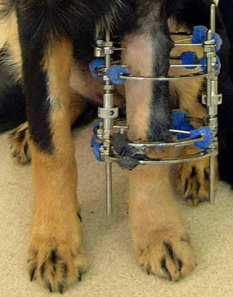How long will the ESF stay in place?
The length of time an ESF will need to stay in place varies from 3 weeks to 4 months - every case is different.
Is a patient with an ESF in pain?
Usually patients tolerate the ESF very well, often even lying normally on the leg with the ESF in place. Patients are often more comfortable with an ESF in place than wearing a bandage or cast because the ESF stabilises structures that would otherwise be painful if they were mobile.
How stable are the pins?
The pins may loosen before the fracture has completely healed. Sometimes, under such circumstances, these loose pins will need to be replaced. The more exercise your pet gets the greater the likelihood that the pins will loosen early on. A loose pin can be recognised by an increase in discharge from around the pin entry point at the skin surface.
I can see a discharge from around the pin, is this normal?
It is normal for there to be a little pink and watery (serous) discharge from around the pins due to the skin and muscle movement around the pin in the first few days following surgery. If this is minimal the discharge should not be cleaned away, but left to form a protective seal. If the discharge is excessive then veterinary attention is needed.
Please call for advice if you are concerned.
Please contact us if:
- There is excessive or odorous (smelly) discharge from around the pins
- There is a deterioration in your pet’s lameness or progress
- There is any change in shape of the ESF or the pins
- There is breakage of one of the pins
- If your pet becomes dull, inappetant (doesn’t eat) or is feverish
ESF Removal
Once the ESF is no longer necessary we will remove it. This can often be done under heavy sedation, or in some patients using a light, short, general anaesthetic. We will only remove the ESF pins when we are satisfied that healing is complete, as far as we are able to assess.

